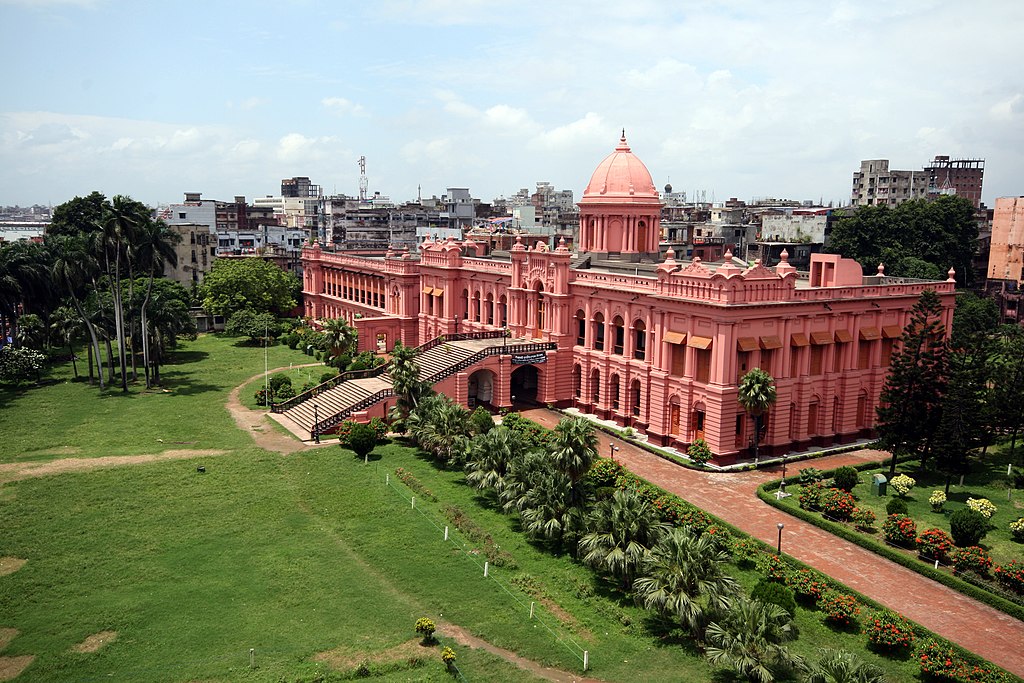Most Visited Tourists Place in Dhaka

Ahsan Manzil used to be the official residential palace and seat of the Nawab of Dhaka.[1] The building is situated at Kumartoli along the banks of the Buriganga River in Dhaka, Bangladesh. Construction was started in 1859 and was completed in 1872.[1] It was constructed in the Indo-Saracenic Revival architecture. It has been designated as a national museum.
In Mughal era, there was a garden house of Sheikh Enayet Ullah, the landlord of Jamalpur Porgona (district), in this place. Sheikh Enayet Ullah was a very charming person. He acquired a very big area in Kumartoli (Kumartuli) and included it in his garden house. Here he built a beautiful palace and named it "Rongmohol" (Rangmahal). He used to enjoy here keeping beautiful girls collected from the country and abroad, dressing them with gorgeous dresses and expensive ornaments. There is a saying that, the founder of Dhaka (representative of mughal emperor) was attracted to one of the beautiful girls. He invited Sheikh Enayet Ullah to a party one night and killed him in a conspiracy when he was returning home. That girl also committed suicide in anger and sorrow. There was a grave of Sheikh Enayet Ullah in the north-east corner of the palace yard which was ruined in the beginning of the 20th century.
Probably in the period of Nawab Alibardi Khan(Grandfather of Nawab Siraj-Ud-Daulah) around 1740 century, Sheikh Moti Ullah, the son of Sheikh Enayet Ullah, sold the property to the French traders. There was a French trading house beside this property. The trading house became wealthier after purchasing this property. In that time, French traders could do business here without paying any taxes by a decree from the emperor Aurangzeb. In that time, the French became very wealthy by doing business here in competition with the English and other European companies. They made a big palace and dug a pond for sweet water in the newly purchased property. The pond still exists in the compound of Ahsan Manzil which was called "Les Jalla" in that time. In the Seven Years' War, French got defeated and all their properties were captured by the English. On 22 June 1757, the French left the trading house with a fleet of 35 boats from the river station of Buriganga in front of Kumartuli.
In 1785, the French transferred the property to a French tradesman named Mr. Champigni, and retaken it at 1801. According to Paris agreement of 1814, the French claimed all their left properties at Dhaka, and in 1827 the property was again returned to the French. For the increasing power of the English, the French was forced to leave subcontinent. They decided to sell all their properties in Dhaka. So in 1830, the trading house of Kumartuli was purchased by the established landlord of Dhaka, Khwaja Alimullah.
After some renovation work, the trading house became the residence of Khwaja Alimullah. In his time, a stable and a family mosque was added in the compound. After his death, his son Nawab Bahadur Sir Khwaja Abdul Ghani made a great flourish to the property, and named it "Ahsan Manzil" after his son Khwaja Ahsanullah. In the east side of the old building, he made a new building with a different design, and also done great renovation work to the old building. Since then, the old building was called "Ondor Mohol" and the new building was called "Rangmahal".
In the evening of 7 April 1888, a devastating tornado hit Dhaka city causing great damage. Ahsan Manzil was severely damaged and abandoned. An English engineer from Kolkata arrived here to examine the palace. He gave an opinion that except for the "Rangmahal", all the other parts of the palace would have to be reconstructed. So Nawab Bahadur Sir Khwaja Abdul Ghani and his son Nawab Bahadur Sir Khwaja Ahsanullah turned their full attention to rebuild the palace. Both of the buildings were reconstructed during that time with a new design and supervised by the local engineer Gobinda Chandra Roy.
The old French building was reconstructed to a two storied building keeping similarity to the Rangmahal. A gangway was made with wood connecting the first floors of the two buildings. The most beautiful thing made in this time was the dome, which made the palace so beautiful.
After the death of Khwaja Ahsanullah in 1901, the glory of Ahsan Manzil was ended. His successors could not continue the glory because of the internal family quarrel. They rented different parts of the palace to tenants, who actually made it a slum. In 1952, govt. acquired the property and left in supervision of the Dhaka Nawab court. In 1985, Dhaka National Museum acquired the property and made it a museum following a massive restoration programme which utilised historic photographs of the property.[2]
fito
Ahsan Manzil is one of the most significant architectural monuments of Bangladesh. The building structure was established on a raised platform of 1 meter, the two-storied palace measures 125.4m by 28.75m. The height of the ground floor is 5 meters and the height of the first floor is 5.8 meters. The thickness of the walls of the palace is about 0.78 meters. There are porticos of 5 meters height on the northern and southern sides of the palace. The building has a broad front-facing the Buriganga River. On the river side, an open spacious stairway leads right up to the second portal and on their stands the grand triple- arched portals. There was once a fountain in the garden in front of the stairs which does not exist today. All along the north and the south side of the building run spacious verandahs with an open terrace projected in the middle.
The palace Ahsan Manzil is divided into two parts: the eastern side and the western side. The eastern building with the dome is called the Rangmahal and the western side with the living rooms is called Andarmahal. The high octagonal dome is placed on the central round room. There is a large drawing room, card room, library, state room and two other guest rooms are located on the east side of the palace. The ballroom, the Hindustani room and few residential rooms are situated on the western side. A beautiful vaulted artificial ceiling, made of wood, decorates the drawing room and the Jalsaghar. A splendid dining hall and few smaller rooms are placed on the west part. The floors of the dining and Darbar Halls are decorated with white, green and yellow colored ceramic tiles. The famous store room, where the valuables of the Nawabs used to be stored, was in the middle of the five rooms located in the western half of the ground floor. Along with those rooms a Darbar Hall or assembly hall and a chest room is also place there.
Dome of Ahsan Manzil
There are attractive wooden stairs in the room that is attached to the north of the domed room. The balusters were ornamented with vine leaves made of iron along the railing of the stairs. The wooden ceiling of the room, decorated with geometric designs, is very elegant. The verandas and rooms are covered with marble. The doorways are placed within semicircular arches. The inner doors had multi-colored glasses. Wooden beams supported the roof of these rooms. The architecture and the decoration is one of a kind in whole Bangladesh.
The construction of the famous dome of the Ahsan Manzil, which is at the center of the palace, took a lot tedious planning. The square room on the ground floor was built with a round shape and brickworks were done around the corners. To give the room an octagonal shape, squinches were given around the roof corners. The eight corners of the octagon was slanted gradually to make the dome look like the bud of a lotus (Kumud Kali). The peak of this dome is 27.13 m above the ground. Ahsan Manzil was severely damaged during the tornado that occurred on 7 April 1888.the western block of Andermahal was completely demolished and later it was entirely rebuilt. The present day dome, which is situated on the top, was built during the time of reconstruction. This place was also damaged during the earthquake of 1897 but Nawab Khwaja Ahsanullah repaired the whole place again.

















